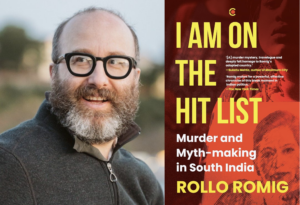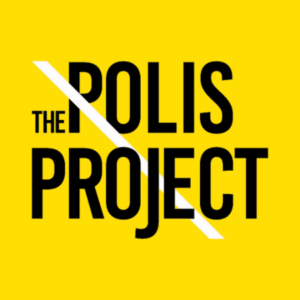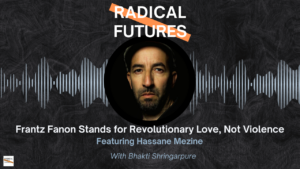
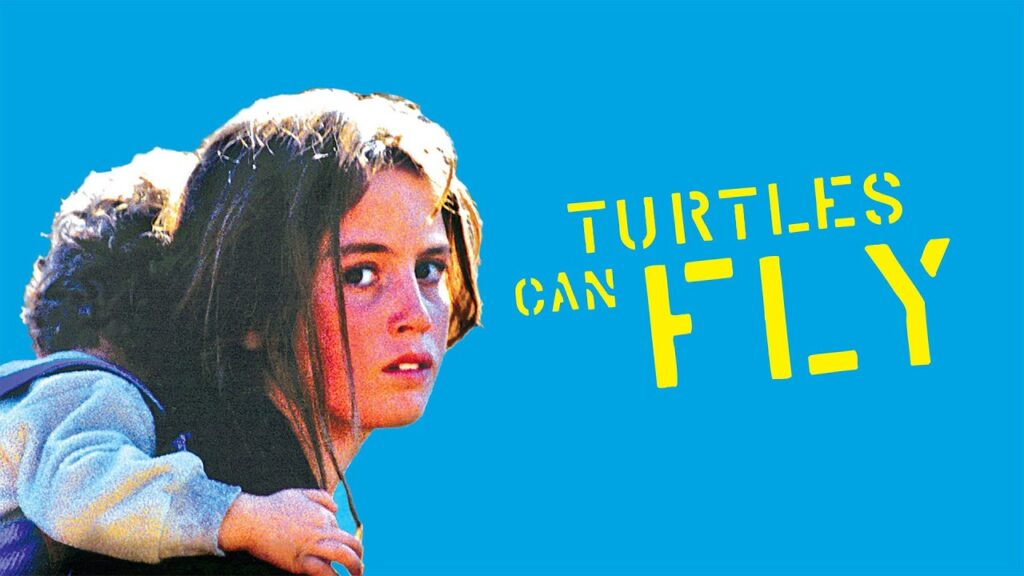
A young boy with amputated arms dives headfirst into a ditch, his teeth clenched around a rusted landmine. Nearby, other children cheer him on as if enjoying a game of marbles. With subversive visuals such as these, Iranian filmmaker Bahman Ghobadi, through his 2004 film Turtles Can Fly, implores us to ask urgent questions: What constitutes childhood innocence? Who are the select children awarded this privilege?
These questions are immensely relevant today. In October 2024, a video of Qamar Subuh, a 6-year-old Palestinian girl, carrying her injured sister, Sumaya, on her shoulder was shared widely across social media. She was trying to return to her family in Al Bureij camp. Like many other children from Gaza who have emerged as the sole breadwinners of their families during the ongoing genocide, Qamar was selling cookies on the street when a car hit Sumaya.
Set in a Kurdish refugee camp on the border of northern Iraq and Turkey, Turtles Can Fly follows a group of Kurdish refugee children and their shrewd transactions with the world, as the threat of US invasion looms over Iraq. Where knowledge is power, the film highlights contrasting routes to information and, by extension, a dichotomy of epistemologies. In a world rife with uncertainty, two central characters, Satellite and Hengov, embody a growing tussle between disinformation campaigns and knowledge rooted in lived experiences.
While Turtles Can Fly proceeds to explore what it means to be a child in a war-torn region, it also offers a resolution between this tussle and an urgent need to reclaim one’s own knowledge systems beyond the colonizer’s frameworks. The plot begins with a group of children giving directions to their fathers and other adults as they adjust television antennae on a hill, emblematic of the story to follow, which is led entirely by children, with adults taking on secondary roles.
Characteristic of most new wave Iranian films—a movement that emerged in the late 1960s and is known for its poetic storytelling, use of non-professional actors, and a focus on philosophical themes with a tinge of realism—children in Ghobadi’s world appear not as aberration to the general order of things made up by the adults, but rather as the very basis of that world order.
Leaders like Satellite, caregivers like Agrin, and prophets like Hengov constitute the fabric of this order, while adults remain either passive or simply absent from the scene. Fourteen-year-old Satellite is the patriarch who commands order in the refugee camp so efficiently that this makeshift order itself crumbles down when the patriarch is injured towards the end of Turtles Can Fly.
This role reversal of adults and children is used by Ghobadi to subvert the First World’s definitions of naivete and innocence by interrogating the very construct of childhood innocence as a prerogative exclusively enjoyed by the West. In a state of normalcy, this innocence operates primarily from a position of passivity and assumes children to be largely non-actors in the world around them. Children in Turtles Can Fly, however, are not the passive, fragile victims of war.
Their innocence lies not in their being non-actors but rather in their insistence on building a world they deem fit for themselves, against the brute force of the oppressor. They lead, scheme, play, and revolt, thus exposing the tragic failure of the 20th-century capitalist world order in stripping them of their most indispensable right—the right to innocence.
Since October 7, 2023, Israel has been killing an average of 30 children every single day, leaving an entire generation of Palestinians physically and psychologically devastated, as children grapple with the indelible scars of relentless violence. While navigating our way between looking at and looking away from this livestreamed genocide that indiscriminately targets children, we, as conscious citizens of the ‘Global South,’ must grapple with the questions Ghobadi asked over two decades ago.
The Western Myth of Childhood “Innocence”
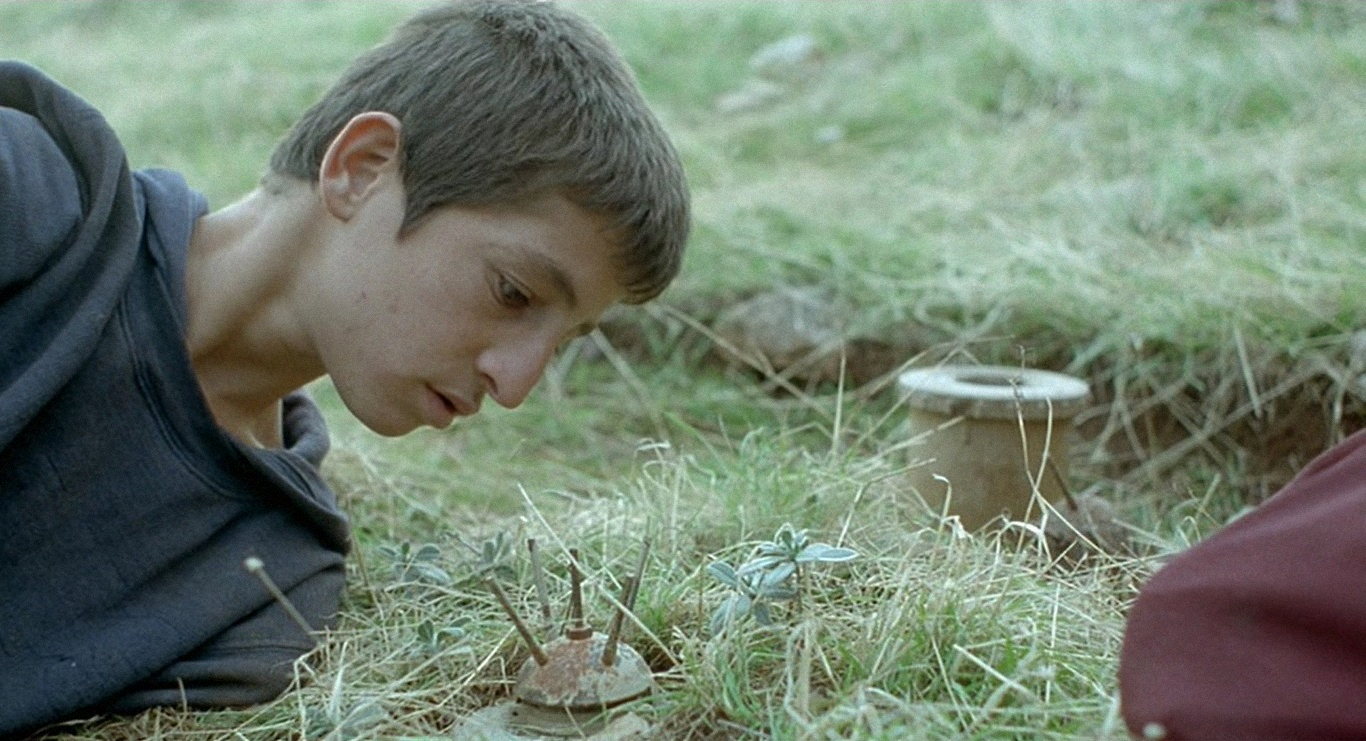
A sight of TV antennae, roads wedged between countryside fields and sparsely distributed tents eventually lead you to the protagonist, Satellite—a bold and quick-witted boy in his early teens, who leads a bunch of children in disarming landmines around the village, and maneuvers his way between the United Nations officials and the black market while trading these landmines.
For those acquainted with the new wave Iranian cinema, it’s no surprise to see children leading the camera to some otherwise inaccessible recesses of society. But the very sight of children playing around with landmines, Kalashnikovs, and gas masks in Turtles Can Fly compels us to reimagine our understanding of naivete and the myth of childhood innocence, which has been largely theorised in the West and continues to influence representations of childhood in mainstream media.
The modern construct of childhood innocence is informed by the works of thinkers like Jean-Jacques Rousseau, who sees childhood as a preparatory stage for adulthood, which requires children to be at leisure and learn under the supervision of adults around them. Most of these seemingly organic and universal dictums that must be followed during the early years of an individual’s life, according to Rousseau, are rooted in a Eurocentric worldview, and access to certain privileges and societal structures that overlook the material realities of the global south, and more so of conflict regions.
In a state of conflict, the “scarred” childhood is one suspended in a limbo that cannot afford to envision the luxury of leisure. It is in this light that we must approach the “brave” children of Palestine and other conflict zones and take cognizance of the fact that this “bravery” that they are lauded for is the only possible state of being for children of conflict.
In his 2016 documentary, Children in Conflict Torn Kashmir, Kashmiri human rights activist Mannan Bukhari explores how direct exposure to violence at the hands of armed personnel continues to debilitate the psyche of the children who grow up bearing psychological—and at times even physical—scars of this violence. “A for Army, B for Bullet, C for Crackdown”, Women’s rights activist and columnist Ezabir Ali points out, in conversation with Bukhari, how children there have devised their own vocabulary under military suppression.
Through characters like Satellite, Ghobadi allows us a glimpse of a more agential childhood that forges its own education amidst the threat of war. As warplanes begin looming over the refugee tents, Satellite leads his bunch at the school, training them in using the weapons he has rented from the neighbouring village of Arbil. In his makeshift schoolroom, standing on a desolate field, the local teacher tries to drive them away and advises them to learn Math and Science instead.
“They know Math and Science,” Satellite responds. “They have to learn how to shoot now, they have to learn how to use masks.”
Satellite further claims, “If it wasn’t for me, they would’ve all been jobless,” as he towers above the rest of the children, while the teacher, in contrast, looks like an almost ridiculed figure with nothing to say in response. In the face of relentless violence and uncertainty, Ghobadi establishes Satellite as a powerful embodiment of a childhood that demands immediate resistance to its existential threat, dismantling the Eurocentric framework of innocence that operates only within a cloistered space of normalcy.
Power Dynamics and Western Propaganda

The sense of power that Satellite is entrusted with seems to be threatened once Hengov arrives. Hengov is a maimed young boy who takes refuge in this camp from the neighbouring village of Halabcheh, along with his sister Agrin and Riga, a toddler who first appears to be their sibling but is later revealed to be the child born out of the rape Agrin is subjected to at the hands of an Iraqi soldier.
As the rumours of war settle in, Satellite is seen advising, encouraging, and almost commanding the village adults to adapt to satellite television to gather information on the impending war. He is revered and doted on by the younger children—and even sought after by the adults to decipher programmes on American news channels.
“War! The world is at war. Everybody is after news,” exclaims the Kurd from Iran, who is looking for Hengov. In this onslaught of information and misinformation, everyone is desperate to gather news and see what lies ahead. To this end, Satellite is summoned by the Governor of the village to translate a news story running on CNN.
He masks his failure at translating the broadcast by claiming that the anchor says it will rain tomorrow. As the story switches from George W. Bush’s “confrontation with terror” to Saddam Hussein’s face, it is only the viewer who sees through Satellite’s artifice, realizing that the programme does not even remotely take into account Kurdish lives in the face of a potential war.
Hengov, on the other hand, who can prophesy the future, emerges as a potent disruptor to this propaganda machinery operating under the guise of information. When Hengov predicts an explosion near the truck where Satellite’s boys unload shells, the latter immediately pays heed and runs after him to seek more information that he can further trade. What some critics read as magical realism in Turtles Can Fly is, in fact, Ghobadi’s attempt at subverting the distorted narratives propelled by the West, as a consequence of America’s global “war on terror.”
The character of Hengov thus reflects a powerful attempt to seek one’s truth that corresponds to one’s first-hand reality, rather than the reality imposed by the colonizer. A possible resonance can be found in the non-traditional journalistic livestreaming approaches that have emerged during the genocide in Palestine to counter the vast reach of Western media operating to manufacture consent. At times, through donation appeals and even through live reporting on social media, the internet’s echo chambers have also subtly incorporated marginalized voices from the ground.
While for the most part, Satellite is convinced that he can lead his people into finding their way out of the information war, he himself is prey to this Western propaganda working in tandem with the colonial power structures post 9/11. Right in the beginning, quite literally tracing the journey of American planes into Iraq on his map, Satellite gleefully cheers, “Not long now before USA comes,” foreshadowing the American warplanes which will further devastate the lives of Kurdish refugees. “There is money in ‘Hello’ these days,” Satellite later claims, as a few customary English phrases help him win the trust of locals and even deal with foreign agents.
For Satellite, Americanization is salvation.
The Persistent Threat Of Death
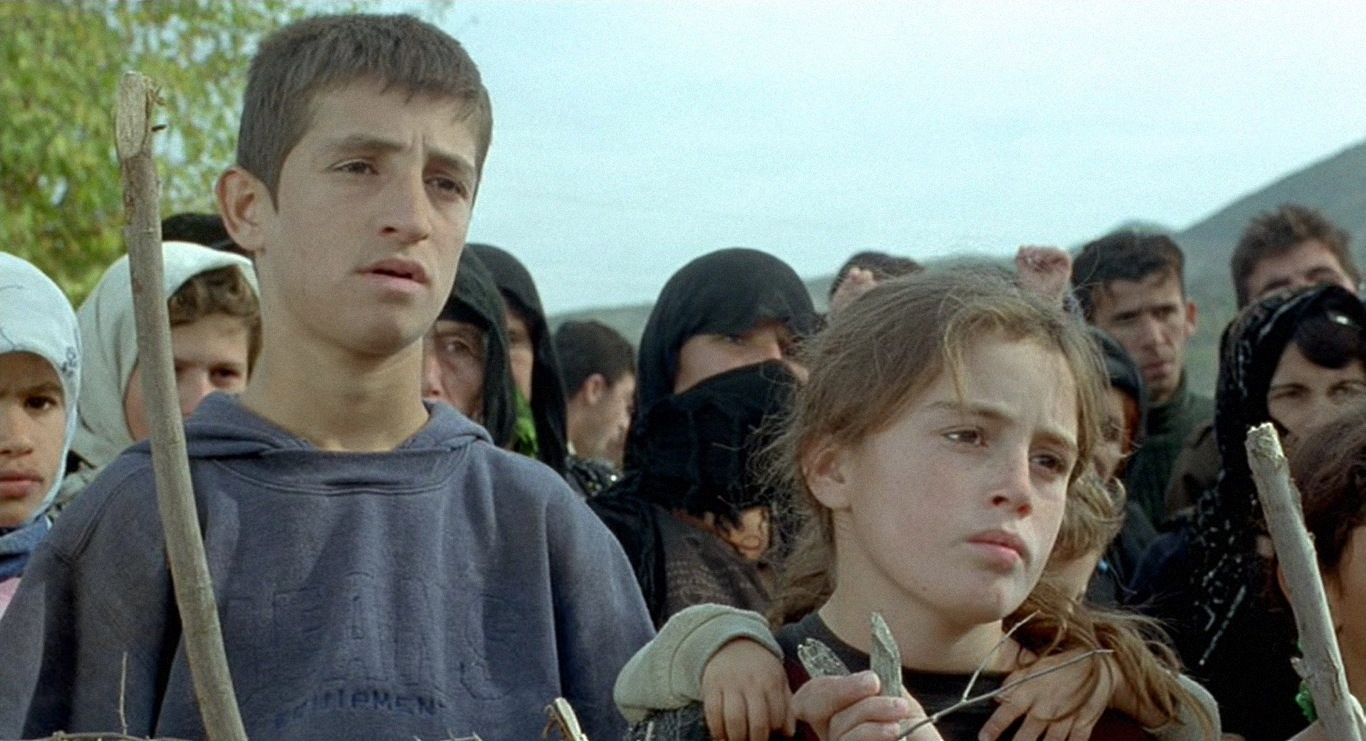
This faith, however, also witnesses a fall as Saddam’s regime falls. The Americans arrive and with them, the false promise of safety and peace for those in this limboland in the form of leaflets saying, “We will make this country a paradise. We are here to take away your problems. We are the best in the world.” But the unanointed pharaoh of this limboland, Satellite, lies with a freshly dismembered leg. As chance would have it, the boy who earns by the landmines himself falls on one while trying to rescue Riga.
Riga, the central conflict in the film, is a toddler who also discerns too much for his age. “The child understands everything, lower your voice,” Hengov says in protest to Agrin, who wants him to leave Riga behind in the village in an attempt to get rid of the insistent reminder of the brutal violence she faced.
The persistent threat of death that looms over Riga finally manifests in a tragic outcome for Satellite. Towards the end of Turtles Can Fly, Riga accidentally ends up on a field of landmines while trying to return to his tent. Satellite vacillates between playing the tyrant and the benefactor for the children throughout the film. But in this scene, he compromises his safety for the partially blind child who gleefully responds to the bicycle horn and frolics around the landmines, unaware that any step could rip him apart.
For Satellite, the landmines thus ultimately bring what they were supposed to bring, not a livelihood, not safety, but only death and destruction. This scene further reinforces how leisure, freedom, and the joy of ‘frolicking around’ are among the first casualties in a world ravaged by war and conflict, as has been the case throughout history.
In the Ganderbal district of Kashmir in August 2015, Muzamil Reshi, along with his two cousins Adil Reshi and Shakir Reshi, went to play on the hillocks near Manasbal Lake when they found an interesting-looking iron object. The object they started playing with turned out to be a littered mortar shell that exploded and claimed the lives of Adil and Shakir and left Muzamil injured.
This incident, which seems to mirror the fate of children in Turtles Can Fly, was not an isolated event. Between 2002 and 2015, in India-controlled Kashmir, 187 people died in littered-shell explosions, of which 97 were minors. For these nowhere children, the explosive greens are their playgrounds. The world is their landmine field.
Children Prematurely Pushed Into Adulthood
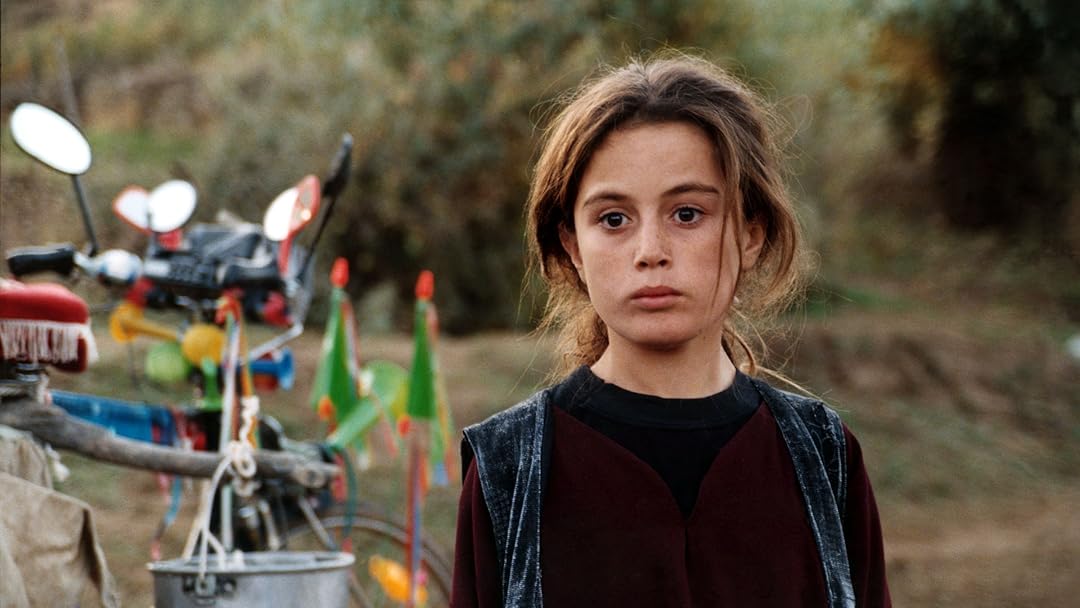
In the form of this physical dismemberment as well as psychological alienation, children in Turtles Can Fly walk around bearing visible scars of the traumas that prematurely pushed them into adulthood. Agrin is one such example whose enigma perplexes the audience and Satellite equally. Satellite closely observes her as she grinds through the hardships of life in displacement, fetching water and preparing meals for Hengov and Riga.
We do not, however, look at Agrin through Satellite’s eyes. She is a child, young, frail, and yet agitated and estranged. She trudges through the village with Riga hunched on her back, visibly carrying the brunt of a violence she is too young to sustain. Her pale face marks an experience that goes beyond her years.
The sight of her crimson robe swaying by the cliff foreshadows the horror to follow. As the audience, we see her and we know that the agony etched on her face is suggestive of the inhuman violence she has been forced to endure. We know how she has been stripped of the luxury of an “untamed”, “innocent” childhood.
This realization, however, is not mirrored in Satellite’s gaze at Agrin, which at once feels direct and sexual—and is anything but innocent. Throughout Turtles Can Fly, we are not given the remotest hint of the whereabouts of Satellite’s parents. However, his demeanour with Agrin and his romantic pursuit of her reflect how he has always been accustomed to fend for himself, even going to the extent of overriding the limits imposed by his age to ‘settle down and marry.’
Satellite first observes Agrin, carefully plays the knight in shining armour in the following days, and takes the conventional route to woo her, even buying her a necklace. This necklace is also made of “international” bullets, suited to Satellite’s preference.
Helping her fetch water by the spring, he finally comes clear and tells Agrin, “I have been looking for a girl like you for years.” With this guileless statement, Satellite becomes the laughing stock. But it’s a comical crisis that both unsettles and arrests the viewers. Because this statement also reveals the hyper-independence of orphans like Satellite in a war-torn region, as he carefully preempts his marriage proposal by asking Agrin, “Do you know someone like yourself who doesn’t have anyone in the world, like you or I?”
Satellite is yet another orphan, yet another number in the war of numbers that we are accustomed to seeing and eventually glossing over on our phone screens and Television sets. In Turtles Can Fly, Ghobadi eternalizes this one moment between the process of looking in and looking away. He renders visible the lives of those who have always existed on the margins.
The film is as much about hope as it is about the harsh reality of existing between the lines. Agrin finally manages to seek liberation from her suffering by drowning Riga along with his pet turtle and jumping off the cliff herself. As the sight of the turtle gliding underwater appears like it’s trying to fly, this scene brings us quietly back to the title of the film. Ghobadi suggests that for these children, the only possible escape from another ‘invasion’ lies in ‘flying’ from the situation entirely.
From this haunting image of a flight in death to the film’s title itself, Turtles Can Fly, is an attempt at reimagining new possibilities as much as it is about a growing disillusionment with the existing world order. It is for the children who continue existing on their own terms against a white, western, colonialist, hetero-patriarchal worldview, and who keep finding innocence in a world that denies them their due right to this innocence.
Finally, it is for the children in the Palestinian novelist Ghassan Kanafani’s world—those who, as he wrote in his 1984 short story collection Palestine’s Children, could not be “temporarily elevated to the skies.”



